News
Cybersecurity Salaries Sky (but Suits Still Make Most)
Reaffirming that it's good to be the boss, the 2021 edition of the Dice salary report shows pay for cybersecurity analysts has skyrocketed, but top-level executives still make much more money.
In the age of ransomware and other attacks, it's perhaps unsurprising that cybersecurity analyst pay grew the most from 2019 to 2020, by a whopping 16.3 percent, bringing salaries up to $103,106. However, even though their pay dropped 1.7 percent, the IT management C-level execs and other top positions averaged $143,416.
"The occupations experiencing the biggest salary increases between 2019 and 2020 were those that helped organizations process and analyze data, digitize and innovate their product offerings, and ensure that their organizations remained efficient, profitable and, perhaps most importantly, safe and secure during the pandemic," said the Dice Tech Salary Report 2021 Edition.
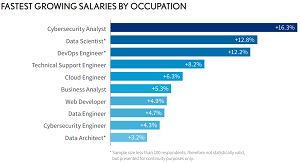 [Click on image for larger view.] Fastest Growing Salaries by Occupation (source: Dice).
[Click on image for larger view.] Fastest Growing Salaries by Occupation (source: Dice).
"The widespread adoption of remote work resulted in widely dispersed networks and teams, with many employees working via their personal laptops and phones," Dice said. "This led to increased vulnerabilities, providing hackers with unprecedented opportunities to attack and breach defenses. In response, the need for skilled technologists to identify and plug these security holes saw Cybersecurity Analyst enjoy the largest growth in salary of any occupation (16.3 percent), rising from $88,663 in 2019 to $103,106 in 2020. This increase outpaces the senior-level Cybersecurity Engineer, which only increased by 4.3 percent, suggesting that shortages in the cybersecurity space have led employers to increase their offers to junior-level technologists."
Here's a graphic from the 2021 report showing average salaries by occupation:
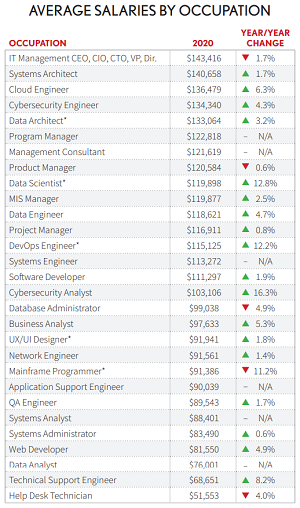 [Click on image for larger view.] Salaries by Occupation (source: Dice).
[Click on image for larger view.] Salaries by Occupation (source: Dice).
Here's a graphic from last year's report (2019 data) for comparison (with no "IT Management CEO, CIO, CTO, VP, Dir" occupation):
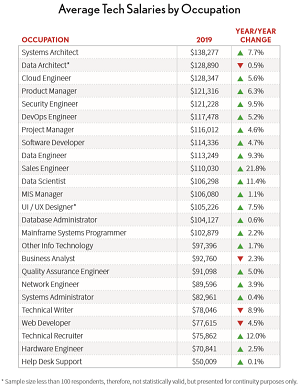 [Click on image for larger view.] 2020 Report Average Tech Salaries by Occupation (source: Dice).
[Click on image for larger view.] 2020 Report Average Tech Salaries by Occupation (source: Dice).
The top-salaried non-management position in the 2021 report is systems architect, followed by cloud engineer, cybersecurity engineer and data architect, though the latter garnered less than the required sample size to be statistically valid. Here's how Dice describes some of the top positions:
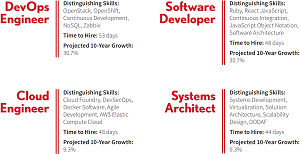 [Click on image for larger view.] Job Descriptions (source: Dice).
[Click on image for larger view.] Job Descriptions (source: Dice).
"As the tech occupation with the highest salary in 2020 (aside from management positions like CIO, CTO, VP, and Director), salaries for Systems Architect roles increased 1.7 percent, reaching $140,658," the report said. "This comes as many businesses have increasingly relied on these technologists to reduce technical debt by designing more modern platforms that enable innovation. Not far behind, Cloud Engineer roles grew 6.3 percent from 2019 to an average salary of $136,479, underscoring the increasing importance and ubiquity of the cloud."
Switching from occupations to skills, the report shows some esoteric, niche ones in the top five, including RabbitMQ and Mockito. The former skill (open source message broker) led both in salary ($136,151) and growth (up 10.1 percent). The skill that saw the biggest decrease in average salary was HANA, the in-memory database.
Here's a graphic from the 2021 report showing highest average salaries by occupation:
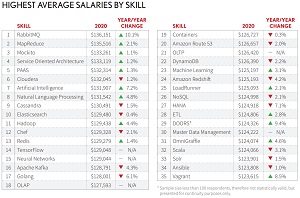 [Click on image for larger view.] Highest Average Salaries by Skill (source: Dice).
[Click on image for larger view.] Highest Average Salaries by Skill (source: Dice).
Here's the graphic from last year's report (2019 data), for comparison:
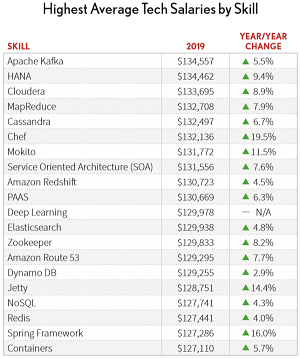 [Click on image for larger view.] 2020 Report Average Tech Salaries by Skill (source: Dice).
[Click on image for larger view.] 2020 Report Average Tech Salaries by Skill (source: Dice).
"When it comes to the highest-paying skills, the trends of the past few years continued to dominate in 2020," Dice said. "Businesses across the country continue to realize the importance of collecting, storing, cleaning, and analyzing enormous amounts of data, as the insights gleaned from that analysis can help executives generate effective long-term strategies. In 2020, the need for fast, accurate data analysis only became more important, and those technologists well-versed in all things related to Big Data found their skills earning a premium salary."
The report is based on a survey of more than 9,000 employed technologists across the country, specifically registered Dice job seekers and site visitors between Sept. 29, 2020, and Dec. 9, 2020. Job posting data was gathered by Dice's partner, Burning Glass Technologies.
"Overall, technologist salaries in the U.S. increased 3.6 percent between 2019 and 2020, reaching an average of $97,859, despite many businesses tightening their budgets in order to weather COVID-19," Dice said. "These organizations needed skilled technologists capable of everything from digital transformation (including moving on-premises tech stacks to the cloud) to ensuring that infrastructure was secure against a rising number of cyberattacks. That demand, combined with a comparatively low tech unemployment rate (standing at 3.5 percent in the third quarter of 2020 [Source: CompTIA] for example, far lower than the national average), led to rising salaries as companies competed for talent."
Other highlights from the report include:
- Fifty-five percent of technologists said they have technical certifications, with the main reason for not having a tech cert was "They are not needed in my role."
- The top certification held by respondents was CompTIA A+ (21 percent), followed by Microsoft Certified Professional (MCP) (17 percent), with a tie for third between CompTIA Security+ and Agile/Scrum (15 percent).
- Fifty-five percent of technologists said they're satisfied with their current salaries. However, given the economic uncertainty from the pandemic, technologists may have lowered their salary expectations, leading to higher levels of satisfaction even if they felt they were underpaid.
- While last year's Tech Salary Report showed the rise of "emerging" benefits (wellness, volunteer opportunities), this year's report illuminates the re-embrace of "staple" benefits such as health insurance and 401(k), which is likely a collateral effect of COVID-19.
- 46 percent of technologists also believe they are underpaid relative to people who shared their occupation and skill level. A full 27 percent said they were satisfied with their compensation despite feeling they don't make enough, while 77 percent of those dissatisfied with their compensation believe they're underpaid (a natural feeling).
- In 2020, 56 percent of technologists said they were satisfied with their current salaries, a noteworthy increase from the 49 percent who reported salary satisfaction in 2019. Those who claimed they were "very satisfied" rose from 16 percent to 22 percent year-over-year, even as the numbers of those either somewhat or very dissatisfied dropped significantly.
- Sixty percent of respondents reported a job increase from the prior year, compared to 52 percent in the prior year's report.
- Forty percent said a potential salary increase was put on hold by the COVID-19 pandemic.
- Texas continues its journey toward becoming a premier tech state, potentially on the scale of California. Both states' tech hubs saw high salaries and steady increases, but Texas also boasts an inflow of prestigious companies building new headquarters and factories, including Oracle and Tesla.
- A "benefit gap" measurement -- the difference between benefits employees deem important vs. those they actually have -- finds training and education at the top, with 68 percent of respondents considering the benefit important, but only 45 percent reporting they have it. The most important benefit was health insurance.
"2020 was an extremely difficult year, as we experienced loss and worked with courage and tenacity to come to terms with an unprecedented situation worldwide," said Art Zeile, CEO, DHI Group Inc. "Amidst that adjustment, there were bright spots, too -- we saw people access an incredible reserve of resourcefulness and perseverance, inspiring acts of kindness and support and, often through accelerated digitization, organizations adapting quickly to the changing landscape. The innovations we saw across the tech world will endure long past the end of the pandemic."
About the Author
David Ramel is an editor and writer at Converge 360.